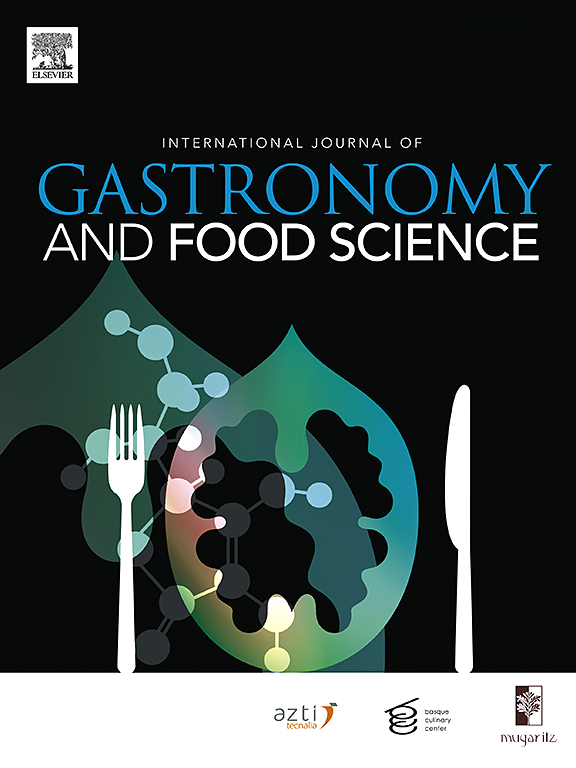Beyond the cup: Unpacking how Brazilians pair coffee with food
IF 3.2
2区 农林科学
Q2 FOOD SCIENCE & TECHNOLOGY
International Journal of Gastronomy and Food Science
Pub Date : 2025-03-04
DOI:10.1016/j.ijgfs.2025.101151
引用次数: 0
Abstract
Coffee is an integral part of Brazilian culture, extending beyond a simple beverage to play a key role in social and culinary traditions. This study explored how Brazilians pair coffee with food, using a mixed-methods approach. A free-listing task (N = 300) identified popular pairings, while projective mapping (N = 48) revealed sensory and contextual dimensions of these associations. Results show that Brazilians enjoy both savory (e.g., pão de queijo, bread, tapioca) and sweet pairings (e.g., cake, chocolate), highlighting regional diversity and challenging global trends that emphasize indulgent pairings like pastries and desserts. Multivariate analysis indicated that certain coffees, such as brewed and filtered varieties, align with daily rituals, while more elaborate preparations, like cappuccino and espresso, are associated with leisure and indulgence. The findings underscore the influence of cultural traditions, emotional connections, and sensory characteristics in coffee pairing practices, demonstrating that these preferences are shaped by routine and accessibility as much as by flavor compatibility. By combining free-listing and projective mapping, this study provides a nuanced understanding of Brazilian coffee culture, contributing to sensory and consumer research. Future research could explore the chemical and sensory mechanisms underlying these pairings and expand on regional and cross-cultural comparisons. These insights offer valuable contributions to the global appreciation of coffee-food harmonization and its potential to celebrate cultural identity.
杯外:巴西人如何将咖啡与食物搭配
咖啡是巴西文化不可分割的一部分,它不仅是一种简单的饮料,而且在社会和烹饪传统中发挥着关键作用。这项研究探索了巴西人如何使用混合方法将咖啡与食物搭配起来。自由列表任务(N = 300)确定了受欢迎的配对,而投影映射(N = 48)揭示了这些关联的感官和上下文维度。结果显示,巴西人既喜欢咸味食物(如p o de queijo、面包、木薯粉),也喜欢甜味食物(如蛋糕、巧克力),这突显了地区多样性,也挑战了强调糕点和甜点等放纵搭配的全球趋势。多变量分析表明,某些咖啡,如煮咖啡和过滤咖啡,与日常仪式相一致,而更精心的准备,如卡布奇诺和浓缩咖啡,与休闲和放纵有关。研究结果强调了文化传统、情感联系和感觉特征对咖啡搭配实践的影响,表明这些偏好不仅受口味兼容性的影响,还受日常习惯和可及性的影响。通过结合自由列表和投影映射,本研究提供了对巴西咖啡文化的细致理解,有助于感官和消费者研究。未来的研究可以探索这些配对背后的化学和感觉机制,并扩大区域和跨文化的比较。这些见解为全球欣赏咖啡食品的和谐及其庆祝文化认同的潜力提供了宝贵的贡献。
本文章由计算机程序翻译,如有差异,请以英文原文为准。
求助全文
约1分钟内获得全文
求助全文
来源期刊

International Journal of Gastronomy and Food Science
Social Sciences-Cultural Studies
CiteScore
5.30
自引率
10.50%
发文量
170
审稿时长
45 days
期刊介绍:
International Journal of Gastronomy and Food Science is a peer-reviewed journal that explicitly focuses on the interface of food science and gastronomy. Articles focusing only on food science will not be considered. This journal equally encourages both scientists and chefs to publish original scientific papers, review articles and original culinary works. We seek articles with clear evidence of this interaction. From a scientific perspective, this publication aims to become the home for research from the whole community of food science and gastronomy.
IJGFS explores all aspects related to the growing field of the interaction of gastronomy and food science, in areas such as food chemistry, food technology and culinary techniques, food microbiology, genetics, sensory science, neuroscience, psychology, culinary concepts, culinary trends, and gastronomic experience (all the elements that contribute to the appreciation and enjoyment of the meal. Also relevant is research on science-based educational programs in gastronomy, anthropology, gastronomic history and food sociology. All these areas of knowledge are crucial to gastronomy, as they contribute to a better understanding of this broad term and its practical implications for science and society.
 求助内容:
求助内容: 应助结果提醒方式:
应助结果提醒方式:


